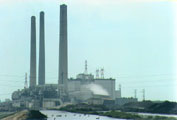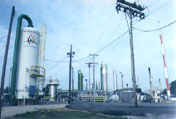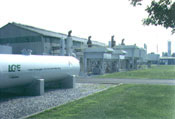LG&E Power Plant Information
» Mill Creek Station
» Cane Run Station (coal-fired)
» Combustion Turbines (natural gas and fuel oil)
» Ohio Falls Station (hydroelectric)
» Muldraugh Natural Gas Compressor Station
» Magnolia Natural Gas Compressor Station
Trimble County Station (coal-fired)
 Began commercial operation in December 1990, with a net generating capacity
of 495 MW. Current generating capacity of 514 MW.
Began commercial operation in December 1990, with a net generating capacity
of 495 MW. Current generating capacity of 514 MW.- One of the most environmentally sound and technologically advanced
coal-fired generation plants in the nation.
- Its capacity increases the reliability of LG&E's electric service
and boosts the company's ability to support economic expansion.
- Its pollution-control equipment includes a high-efficiency electrostatic
precipitator and a state-of-the-art wet limestone scrubber that
removes more than 90 percent of the sulfur dioxide from the flue gas.
The station's generating unit can operate only when the scrubber is
running.
- In compliance with Clean Air Act requirements for sulfur-dioxide removal
for the year 2000.
- Burns up to 200 tons per hour of coal which is transported in 1,500-ton
barges.
- The natural draft hyperbolic cooling tower provides efficient cooling of river water for
reuse in the generation process.
- Plant site includes a 114-acre wildlife preserve composed of wetlands and
forested areas.
- Illinois Municipal Electric Agency owns 12.12 percent of the plant, and Indiana Municipal Power Agency owns 12.88 percent.
Mill Creek Station (coal-fired)
 Began commercial operation in 1972. The plant's net summer capacity
of 1,470,000 kilowatts makes it LG&E's largest generating
station.
Began commercial operation in 1972. The plant's net summer capacity
of 1,470,000 kilowatts makes it LG&E's largest generating
station.- All units are fully scrubbed, meeting the Clean Air Act's Phase II standards for sulfur-dioxide emissions.
- LG&E's first generating station to utilize cooling towers. Mechanical-draft cooling
towers are installed on 3 of its 4 units to protect the Ohio River's aquatic life.
- Burns 3.7 million tons of coal per year. Most coal was delivered in 100-ton railroad
hopper cars until 1983, when the company's first permanent coal-barge unloading facility was constructed at the plant.
- Produces over 500,000 tons of gypsum, a scrubber by-product, per year for use in manufacture of wall board for home construction industry.
 Plant site covers 510 acres.
Plant site covers 510 acres.- Began commercial operation in 1954 in response to the demand for electricity by industries that located in Louisville during World War II. Three of its six units are now retired. Units 4, 5 and 6 have a net generating capacity of 563,000 kilowatts.
- Burns 1.3 million tons of coal per year all of which is transported by rail.
- Three units were retrofitted with scrubbers between 1976 and 1979. Cane Run Station meets the Clean Air Act's Phase II standards for sulfur-dioxide emissions.
- The company's first sludge-processing plant began operation in 1980 to serve Unit 6 and its scrubber. A similar waste processing plant for Units 4 and 5 and their scrubbers went into operation in 1981. A processing plant produces environmentally acceptable landfill material from flyash, lime and scrubber by-product.
Combustion Turbines (natural gas and fuel oil)
- LG&E has six combustion turbines. These small power plants are used to meet energy demands during peak electricity-usage periods and emergency start-ups.
- Two of the combustion turbines began operation in 1964, when LG&E became the first company in the electric-utility industry to use new jet engines to drive existing generators.
- Turbines are located at Waterside Station, Paddy's Run, Cane Run and Zorn Avenue.
Ohio Falls Station (hydroelectric)
- Began commercial operation in 1928. At that time, the station was the seventh-largest hydroelectric plant in the country.
- The company is in the process of rehabilitating the facility's eight generating units.
- Upon completion of the rehabilitation project, the facility's total generation capacity will be 100 megawatts.
Muldraugh Storage Area
 Included in the Muldraugh Storage Area are two gas storage reservoirs, compressor station and gas processing plants, and high-pressure gas transmission lines associated with the operation of gas storage and transmission system.
Included in the Muldraugh Storage Area are two gas storage reservoirs, compressor station and gas processing plants, and high-pressure gas transmission lines associated with the operation of gas storage and transmission system.- LG&E purchases gas that is transported by either Texas Gas Transmission Corporation or by Tennessee Gas Pipeline, from the gas production areas in Texas, Louisiana and Gulf of Mexico. During the non-heating season, LG&E injects the gas into underground storage reservoirs. That gas is then drawn from the storage fields and delivered to LG&E's distribution system during the heating season. Additionally, gas is taken directly from Texas Gas and delivered to LG&E's distribution system. LG&E's gas storage allows LG&E to purchase gas more efficiently, by taking advantage of differences in gas prices between summer and winter.
Storage Reservoirs
Muldraugh Storage Reservoir
Storage Capacity - 4.6 Billion Cubic Feet
Number of wells - 52 injection/withdrawal, 6 observation wells
Storage Formation - Devonian Jeffersonville
Surface Area - 900 acres
History - Muldraugh storage field went into operation in 1931 and is recognized as one of the first gas storage reservoirs in the United States. The storage field was originally a gas production field located nearby the community of Muldraugh.
Doe Run Storage Reservoir
Storage Capacity - 5.8 BCF
Number of wells - 84 injection/withdrawal, 8 observation wells
Storage Formation - Devonian Jeffersonville
Surface Area - 4,000 acres
History - Doe Run storage field went into operation in 1946 and is recognized as the first aquifer gas storage field in the nation. The storage formation was originally water saturated and LG&E injected gas into the formation displacing the water.
Muldraugh Compressor Station
 Number of compressor units - 7 reciprocating compressors and 2 gas turbine compressor units
Number of compressor units - 7 reciprocating compressors and 2 gas turbine compressor unitsTotal amount of compression horsepower - 9,545
Number of gas de-sulfurization processing units - 3
Number of gas dehydration processing units - 1
Total gas processing capacity of compressor station - 260 million cubic feet per day
Each gas reciprocating engine stands 10 feet high, is 12 feet wide by 20 feet long, and has 8 power cylinders that measure 18 inches across. Each engine drives 4 reciprocating compressors that compress gas withdrawn from storage. The engines are powered by natural gas.
Each gas turbine is rated at 1,250 horsepower and drives one centrifugal compressor that compresses gas withdrawn from storage. The gas turbines operate at 23,000 rpm and are powered by natural gas.
Magnolia Natural Gas Compressor Station and Storage Field
Magnolia Storage Area
Included in the Magnolia Storage Area are three gas storage reservoirs, compressor station, gas processing plants, and high-pressure gas transmission lines associated with the operation of the gas storage and transmission system.
Storage Reservoirs
Magnolia Upper Storage Reservoir
Storage Capacity - 6.0 Billion Cubic Feet
Number of wells - 82 injection/withdrawal, 9 acres of observation wells
Storage Formation - Silurian Lego
Surface Area - 9,600
History - Magnolia Upper storage field was originally a gas production field converted by LG&E to a gas storage field. The storage field was placed into operation in 1958 and is located nearby the community of Magnolia in LaRue County, Kentucky. Portions of the storage field also lie in Green and Hart counties.
Magnolia Deep Storage Field
Storage Capacity - 4.4 BCF
Number of wells - 53 injection/withdrawal, 16 observation wells
Storage Formation - Silurian Laurel
Surface Area - 9,600 acres
History - Magnolia Deep storage field lies directly beneath the Magnolia Upper storage field.
Center Storage Field
Storage Capacity - 5.2 Billion Cubic Feet
Number of wells - 116 injection/withdrawal, 113 observation wells
Storage Formation - Silurian Laurel
Surface Area - 15,000 acres
- History - Center Storage field was originally a gas production field that was converted to gas storage and placed into operation in 1966.
Magnolia Compressor Station
Number of compressor units - 6 reciprocating
Total amount of compression horsepower - 8,010
Number of gas de-sulfurization processing units - 2
Number of gas dehydration processing units - 2
Total gas processing capacity of compressor station - 120 million cubic feet per day
Each gas reciprocating internal combustion engine stands 10 feet high, is 12 feet wide by 24 feet long and has either 10 or 12 power cylinders. Each engine drives 4 or 5 reciprocating compressors that compress gas withdrawn from storage. The engines are powered by natural gas.

